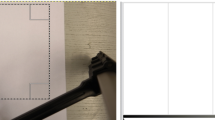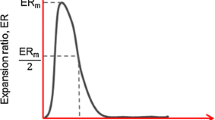Abstract
This paper reviews development exploitation semi and full automatic strategies for interpretation of Polypropylene Modified Bitumen (PMB) in the last decade. The main purpose of this study is to provide a new automatic method for the interpretation of Polypropylene Modified Bitumen (PMB) properties. An image-based system was developed for interpretation. Several statistical criteria were developed based on Fuzzy segmentation (FCM) and Radon transform for approximation of polypropylene features, which include the High Amplitude Radon Percentage, High Energy Radon Percentage, Standard Deviation, Momentum and a set of Morphological Features (number, position, area, value, etc.). Optical microscopy was used to take the images from membrane of PMB bitumen samples at an intensification measure of 100 ×. Theoretical analysis and experimental results are addressed in this paper.


































Similar content being viewed by others
References
Acharya UR, Fujita H, Sudarshan VK, Mookiah MRK, Koh JE, Tan JH, Hagiwara Y, Chua CK, Ng KH (2016) An integrated index for identification of fatty liver disease using radon transform and discrete cosine transform features in ultrasound images. Inf Fusion 31:43–53. https://doi.org/10.1016/j.inffus.2015.12.007
Airey GD (2003) Rheological properties of styrene butadiene styrene polymer modified road bitumens. Fuel 82(14):1709–1719. https://doi.org/10.1016/S0016-2361(03)00146-7
Al-Hadidy AI, Yi-qiu T (2009) Mechanistic approach for polypropylene-modified flexible pavements. Mater Des 30(4):1133–1140. https://doi.org/10.1016/j.matdes.2008.06.021
Bezdec JC (1981) Pattern recognition with Fuzzy objective function algorithms. Plenum Press, New York
González O, Peña J, Muñoz M, Santamaría A, Pérez-Lepe A, Martínez-Boza F, Gallegos C (2002) Rheological techniques as a tool to analyze polymer-bitumen interactions: Bitumen modified with polyethylene and polyethylene-based blends. Energy Fuels 16(5):1256–1263. https://doi.org/10.1021/ef020049l
Gumustekin S, Topal A, Sengoz B (2011) Texture analysis of polymer modified bitumen images. Int J Mater Res 102(5):513–520. https://doi.org/10.3139/146.110510
Huang H, White T (1996) Dynamic properties of fiber-modified overlay mixture. Transp Res Rec 1545:98–104. https://doi.org/10.3141/1545-13
Kashyap KL, Bajpai MK, Khanna P (2018) An efficient algorithm for mass detection and shape analysis of different masses present in digital mammograms. Multimed Tools Appl 77(8):9249–9269. https://doi.org/10.1007/s11042-017-4751-5
Liu X, Chen X, Liu C (2017) Image processing in welding seam tracking with structure-light based on Radon transform and fuzzy-enhancement. Hanjie Xuebao Trans China Weld Inst 38(2):19–22
Maniruzzaman AM, Hamad A, Maleka A, Elsergany M (2015) Rheological properties of cellulose oil palm fiber (COPF) modified 80-100 asphalt binder. J Adv Res Appl Mech 7(1):21–30. ISSN (online): 2289–7895
Moghaddam TB, Soltani M, Karim MR, Baaj H (2015) Optimization of asphalt and modifier contents for polyethylene terephthalate modified asphalt mixtures using response surface methodology. Measurement 74:159–169. https://doi.org/10.1016/j.measurement.2015.07.012
Nejad FM, Zakeri H (2011) An optimum feature extraction method based on Wavelet-Radon Transform and Dynamic Neural Network for pavement distress classification. Expert Syst Appl 38(8):9442–9460. https://doi.org/10.1016/j.eswa.2011.01.089
Ouma YO, Hahn M (2016) Wavelet-morphology based detection of incipient linear cracks in asphalt pavements from RGB camera imagery and classification using circular Radon transform. Adv Eng Inform 30(3):481–499. https://doi.org/10.1016/j.aei.2016.06.003
Otsu N (1979) A threshold selection method from gray-level histograms. IEEE Trans Syst Man Cybern 9(1):62–66. http://ieeexplore.ieee.org/stamp/stamp.jsp?arnumber=4310076
Patel V, Parmar A, Kotak B, Patel D, Patel M (2015) Enhancement into bituminous properties using Forta fibre in SMA. Int J Innov Res Sci Technol 1(8):79–83. ISSN: 2349–6010 http://www.ijirst.org/articles/IJIRSTV1I8020.pdf
Polacco G, Stastna J, Biondi D, Zanzotto L (2006) Relation between polymer architecture and nonlinear viscoelastic behavior of modified asphalts. Curr Opin Colloid Interface Sci 11(4):230–245. https://doi.org/10.1016/j.cocis.2006.09.001
Rodríguez-Valverde M, Ramón-Torregrosa P, Páez-Dueñas A, Cabrerizo-Vílchez M, Hidalgo-Álvarez R (2008) Imaging techniques applied to characterize bitumen and bituminous emulsions. Adv Coll Interface Sci 136(1):93–108. https://doi.org/10.1016/j.cis.2007.07.008
Sengoz B, Isikyakar G (2008) Analysis of styrene-butadiene-styrene polymer modified bitumen using fluorescent microscopy and conventional test methods. J Hazard Mater 150(2):424–432. https://doi.org/10.1016/j.jhazmat.2007.04.122
Subramaniam B, Radhakrishnan S (2018) Multiple features and classifiers for vein based biometric recognition. Biomedical Research (India), 2018 (Special Issue Computational Life Sciences and Smarter Technological Advancement), S8–S13
Shi L, Wang D, Wu W, Qian N (2016) Study of asphalt mixture skeleton based on digital image processing. Jianzhu Cailiao Xuebao J Build Mater 19(4):767–772. https://doi.org/10.3969/j.issn.1007-9629.2016.04.028
Tapkin S (2008) The effect of polypropylene fibers on asphalt performance. Build Environ 43(6):1065–1071. https://doi.org/10.1016/j.buildenv.2007.02.011
Tapkin S, Ozcan S (2012) Determination of the optimal polypropylene fiber addition to the dense bituminous mixtures by the aid of mechanical and optical means. Balt J Road Bridge Eng 7(1):22–29. https://doi.org/10.3846/bjrbe.2012.03
Tapkin S, Cevik A, Usar U (2009) Accumulated strain prediction of polypropylene modified Marshall specimens in repeated creep test using artificial neural networks. Expert Syst Appl 36(8):11186–11197. https://doi.org/10.1016/j.eswa.2009.02.089
Tapkin S, Cevik A, Usar U (2010) Prediction of Marshall test results for polypropylene modified dense bituminous mixtures using neural networks. Expert Syst Appl 37(6):4660–4670. https://doi.org/10.1016/j.eswa.2009.12.042
Tapkin S, Sengoz B, Sengul G, Topal A, Ozcelik E (2015) Estimation of polypropylene concentration of modified bitumen images by using k-NN and SVM classifiers. J Comput Civ Eng 29(5):04014055. https://doi.org/10.1061/(ASCE)CP.1943-5487.0000353
Tapkin S, Usar U, Ozcan S, Cevik A (2011) Polypropylene fiber-reinforced bitumen. In: McNally T (ed) Polymer modified bitumen: properties and characterization. Woodhead Publishing, U.K., pp 136–194
Tapkin S, Usar Ü, Tuncan A, Tuncan M (2009) Repeated creep behavior of polypropylene fiber-reinforced bituminous mixtures. J Transp Eng 135(4):240–249. https://doi.org/10.1061/(ASCE)0733-947X(2009)135:4(240)
Topal A, Yilmaz M, Kok BV, Kuloglu N, Sengoz B (2011) Evaluation of rheological and image properties of styrene-butadiene-styrene and ethylene-vinyl acetate polymer modified bitumens. J Appl Polym Sci 122(5):3122–3132. https://doi.org/10.1002/app.34282
Toraldo E, Mariani E, Malvicini S (2015) Laboratory investigation into the effects of fibers on bituminous mixtures. J Civ Eng Manag 21(1):45–53. https://doi.org/10.3846/13923730.2013.802720
Vadood M, Semnani D (2011) Optimization of fiber distribution in spunbond non-woven structure. Fibers Polym 12(6):821–829. https://doi.org/10.1007/s12221-011-0821-x
Vadood M, Johari MS, Rahai A (2014) Developing a hybrid artificial neural network-genetic algorithm model to predict resilient modulus of polypropylene/polyester fiber-reinforced asphalt concrete. J Text Inst. https://doi.org/10.1080/00405000.2014.985882
Vadood M, Johari MS, Rahai AR (2015) Relationship between fatigue life of asphalt concrete and polypropylene/polyester fibers using artificial neural network and genetic algorithm. J Central South Univ 22(5):1937–1946. https://doi.org/10.1007/s11771-015-2713-5
Zakeri H, Nejad FM, Fahimifar A, Fazel ZM (2014) A new automatic MF generator (AMFG) for general 3D type-II fuzzy in the polar frame. In: 2014 IEEE conference on Norbert Wiener in the 21st Century, Boston, MA, USA. https://doi.org/10.1109/norbert.2014.6893899
Zakeri H, Nejad FM, Fahimifar A, Zarandi M (2013) A multi-stage expert system for classification of pavement cracking. In: 2013 joint IFSA world congress and NAFIPS annual meeting (IFSA/NAFIPS), https://doi.org/10.1109/ifsa-nafips.2013.6608558
Zakeri H, Nejad FM, Fahimifar A (2016) Rahbin: A quadcopter unmanned aerial vehicle based on a systematic image processing approach toward an automated asphalt pavement inspection. Autom Constr 72:211–235. https://doi.org/10.1016/j.autcon.2016.09.002
Zarandi MF, Nejad FM, Zakeri H (2012) A type-2 fuzzy model based on three dimensional membership functions for smart thresholding in control systems. INTECH Open Access Publ. https://doi.org/10.5772/47798
Zhou L, Li P, Zhang Z, Chen H (2008) Analysis of effect of fiber on high temperature performance of asphalt mixture. J Wuhan Univ Technol 30(11):58–61. http://en.cnki.com.cn/Article_en/CJFDTotal-WHGY200811015.htm
Author information
Authors and Affiliations
Corresponding author
Ethics declarations
Conflict of interest
All authors states that there is no conflict of interest.
Additional information
Publisher's Note
Springer Nature remains neutral with regard to jurisdictional claims in published maps and institutional affiliations.
Rights and permissions
About this article
Cite this article
Tapkın, S., Zakeri, H., Topal, A. et al. A Brief Review and a New Automatic Method for Interpretation of Polypropylene Modified Bitumen Based on Fuzzy Radon Transform and Watershed Segmentation. Arch Computat Methods Eng 27, 773–803 (2020). https://doi.org/10.1007/s11831-019-09323-1
Received:
Accepted:
Published:
Issue Date:
DOI: https://doi.org/10.1007/s11831-019-09323-1




